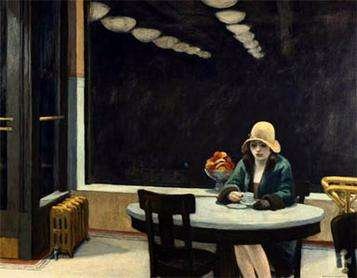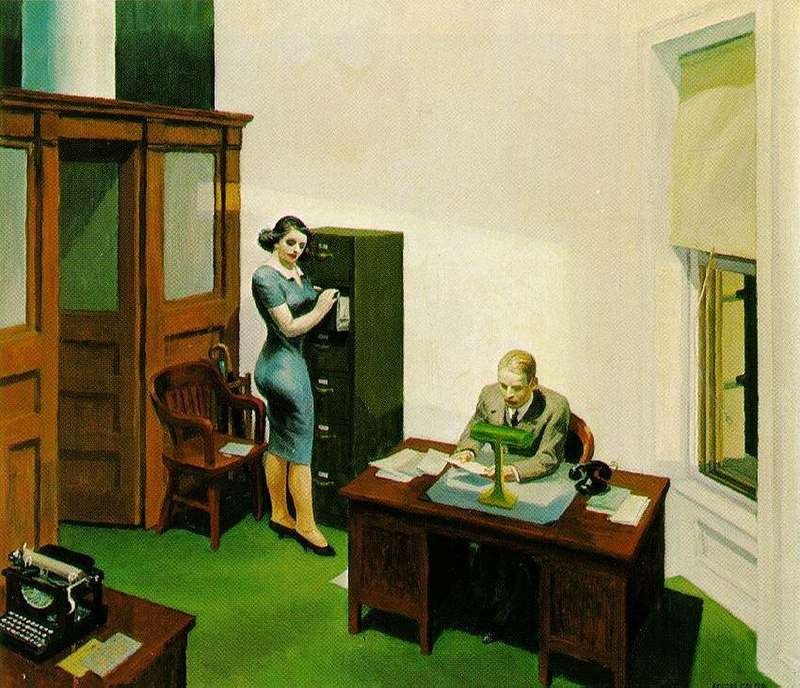Most people are familiar with the paintings of American artist Edward Hopper (1882-1967). He is considered the first significant American artist of the 20th Century. He has enjoyed success and popularity since the 1950s.
Edward Hopper is one of America’s favorite and most known artists whose scenes of America, cityscapes, natural landscapes, and everyday life hits popular universal and shared experiences. He painted poetic images of commonplace hotel rooms, diners, gas stations, roads, and buildings.
His painting are compelling and capture the imagination with scenes of subtle drama and often stark loneliness. Hopper’s paintings exude an unusual tranquility and stillness. The Smithsonian Art Gallery says his work “touches us where we are most vulnerable.”
In a 1953 interview in Reality Magazine, Hopper stated that “great art is the outward expression of an inner life in the artist, and this inner life will result in his personal vision of the world.”
Nighthawks

Nighthawks, 1942, oil on canvas, Art Institute of Chicago.
One of America’s most iconic paintings which has been used in many film and artistic productions. A lonely scene of four people at a downtown diner late at night in Greenwich Village, NYC. The people are turned inward upon themselves, ambivalent and isolated from each other. Looking in through the window which is a physical barrier and has a model like effect like a showcase or aquarium. The painting plays on lights and shadows creating a feeling of loneliness and isolation. Light from the diner illuminates the dark and deserted streets.
Automat

Automat, 1927, oil on canvas, Des Moines Art Center.
A lonely scene stripped of any glitz of a woman wearing a winter coat in an automat fast food restaurant among a night blackened window in Time Square, NYC. The woman wears a winter coat with one glove still on which suggests hurry and unrest. She is turned inward upon herself. The lights above floats creating an unreal feeling.
House by the Railroad

House by the Railroad, 1925, oil on canvas, Museum of Modern Art, NYC.
One of Hopper’s most famous of an old Victorian house along the rail line in Haverstraw, New York. The harsh interplay of light and shadow makes the abandoned house seems threatening with an eerie, chimerical look, with a sense of vertigo. Hopper plays tricks on perspective: the horizon is in the foreground, the house has no solid frame of reference, it seems to hover in the air and appears to tilt forward.
Chop Suey

Chop Suey, 1929, oil on canvas, Christie’s, New York City.
A fresh and iconic scene of two women drinking tea in a Chinese restaurant on Columbus Circle in New York City. A Hopper common theme of urban existence of isolation.
Office At Night

Office At Night, 1940, oil on canvas, Walker Art Center, Minneapolis.
The painting has a subtle sexual and suspenseful mood, as if something strange is going on. The overemphasized woman’s figure creates a sexual tension which is underscored by the patch of light from the window touching both figures.
Early Morning Sunday

Early Moring Sunday, 1939, Whitney Museum, New York City.
A bleak empty street during the Great Depression with long shadows cast by the morning sun. The extremely long horizontal format suggests a camera panning the store front. An unreal stage set façade with no beginning or end and no vertical interruption.
Office in a Small City

Office in a Small City, 1953, oil on canvas, Metropolitan Museum of Art, NYC.
Depicts loneliness and beauty in a uniquely stark urban setting. The title is purely subjective where the point of view is artificial like a camera photo. The buildings are blank concrete walls that contrast the office interior.



